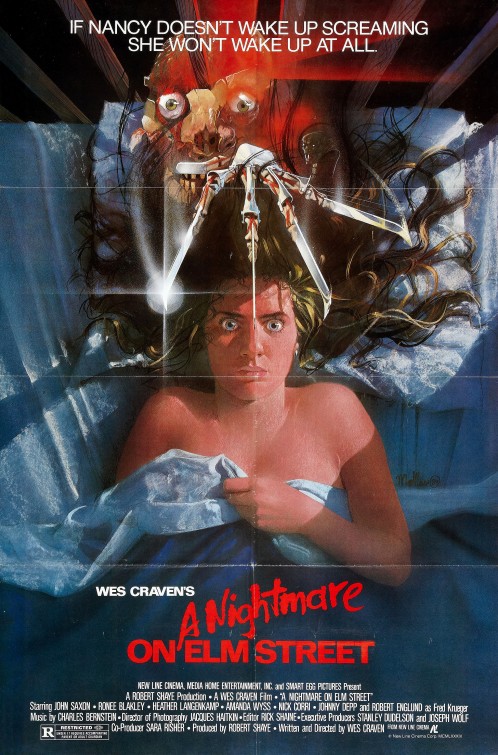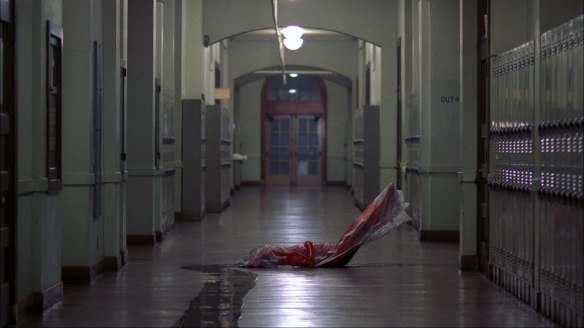With nine or so sequels, re-makes, re-boots, or meta-versions, “A Nightmare on Elm Street” is one of the most prolific films in cinema history. It will be the signature film of Wes Craven’s career and it will also be the film that first starred Johnny Depp. Talking about the movie at this point may seem unnecessary, but historical context and some personal touches might give you a couple of reasons to bother with another post on an iconic horror film.
 The horror genre in the early eighties was dominated by slasher films. Sequels to “Halloween” and “Friday the Thirteenth” came up almost yearly, copy cats like “Terror Train” or “The Funhouse” were everywhere. It’s true that occasional supernatural films broke through and grabbed some attention, but the reliable killer in a mask usually came back to haunt the teenagers of the time. “A Nightmare on Elm Street” crosses the slasher film with a ghost/demon story and then finds the perfect twist to work as the spine of the enterprise. Freddy Krueger is a slasher, but he is a dead slasher. He also has supernatural powers that he will use to take out his victims but best of all, the attacks happen in the nightmares of the kids he is stalking. This was something fresh.
The horror genre in the early eighties was dominated by slasher films. Sequels to “Halloween” and “Friday the Thirteenth” came up almost yearly, copy cats like “Terror Train” or “The Funhouse” were everywhere. It’s true that occasional supernatural films broke through and grabbed some attention, but the reliable killer in a mask usually came back to haunt the teenagers of the time. “A Nightmare on Elm Street” crosses the slasher film with a ghost/demon story and then finds the perfect twist to work as the spine of the enterprise. Freddy Krueger is a slasher, but he is a dead slasher. He also has supernatural powers that he will use to take out his victims but best of all, the attacks happen in the nightmares of the kids he is stalking. This was something fresh.
Thirty years later, everyone knows how the premise works, but in 1984, we did not all realize that sometimes we would be in a dream and sometimes in the real world. That uncertainty is one of the things that made the fright elements of the movie work well. In the opening sequence, “Tina” is hunted through a nightmarish world of alleys, basements and warehouses. It is dark and she is in a nightgown and seems vulnerable immediately. That she wakes up and clutches a crucifix off the wall, is the first indicator that she has to dream for these horrifying things to happen to her. The crossover effect is a bit difficult to reconcile with the real world conditions that we see. Sometimes the only evidence that the events took place are subtle, slashes in a nightgown for instance. When the first victim does get killed, there is no doubt that the results are real and the blood on the walls shows that it it not simply someone dying in their dreams.
Earlier in the year, the film “Dreamscape” visualized battles that took place in the subconscious while the victim was sleeping. In that film however, there is never any outward manifestation of the injuries the victims receive in their dreams. The victims simply appear to have died in their sleep. In this movie, the victim does not just moan and expire. Bodies are dragged across the ceiling, guts are exploded on the floor and necks are bruised by strangulation.  One of the things that made these movie work so well was the creative use of practical effects to achieve the horror. Two deaths are shown that required an elaborate trundle set to accomplish. The eery effect of a body being flung to the ceiling and cut up there while an onlooker struggles to reach the victim, is not a computer image but a real shot created using old school techniques that are a lot more convincing than the computer images we usually see these days.
One of the things that made these movie work so well was the creative use of practical effects to achieve the horror. Two deaths are shown that required an elaborate trundle set to accomplish. The eery effect of a body being flung to the ceiling and cut up there while an onlooker struggles to reach the victim, is not a computer image but a real shot created using old school techniques that are a lot more convincing than the computer images we usually see these days.
The first time I saw this movie was on a rainy Monday night in Pasadena California. The United Artists Theater was a cavernous single screen theater, located on Colorado Blvd. As my wife and I entered the room, it was extremely cold and we were the first customers for that screening. Anticipating a spooky evening, we choose the back row of seats to sit in. Although a couple more folks came in, it was still a very lonely and creepy experience. We had left while the L.A. Raiders (that’s right, L.A. was their home that year) were playing a Monday night game. The game was still on when we got back, and frankly I was happy to have a little football to wash off the scary moments of the film.
This was not a simple slasher film, this movie had a great idea and ran with it. Wes Craven did not limit his work to just the death scenes. One of the best moments of the movie happens when the lead character Nancy, falls asleep in class and sees her dead friend in the hallway of the school, occupying the body bag that she was taken away in.  As she goes to investigate, the body is dragged mysteriously down the hallway by an invisible force. The image is very effective, even if it is achieved with the use of wires. When she encounters a hall monitor who demands her pass, anyone paying attention would know that something was up based on the clothing of the girl. This nifty bit of business is just one of the many small but well visualized moments that come between the major death scenes.
As she goes to investigate, the body is dragged mysteriously down the hallway by an invisible force. The image is very effective, even if it is achieved with the use of wires. When she encounters a hall monitor who demands her pass, anyone paying attention would know that something was up based on the clothing of the girl. This nifty bit of business is just one of the many small but well visualized moments that come between the major death scenes.
Nancy has a couple of other moments that raise the bar as well. The sequence of her passing out in the bathtub is suspenseful and disturbing at the same time.  As Freddy’s clawed hand reaches up between her knees, a thousand people will be swearing off of taking a bath or using bubbles during a bath because of that image. No where is safe when the monster that is after you is in your dreams and not just in your house. Robert Englund as Freddy really does not have many lines in the movie. It was not until later versions that he became a demonic punster or the stand up from hell. There is however one indication of the twisted humorous direction the film series would take. When Nancy answers the phone that she has just ripped out of the wall and Freddy tongues her through the receiver,
As Freddy’s clawed hand reaches up between her knees, a thousand people will be swearing off of taking a bath or using bubbles during a bath because of that image. No where is safe when the monster that is after you is in your dreams and not just in your house. Robert Englund as Freddy really does not have many lines in the movie. It was not until later versions that he became a demonic punster or the stand up from hell. There is however one indication of the twisted humorous direction the film series would take. When Nancy answers the phone that she has just ripped out of the wall and Freddy tongues her through the receiver, he tells her “I’m your boyfriend now.” That is the seed from which all the future quips spewed by Freddy in the rest of the series comes from. The disturbing image of the phone tongue is something a sick but creative mind is required for.
he tells her “I’m your boyfriend now.” That is the seed from which all the future quips spewed by Freddy in the rest of the series comes from. The disturbing image of the phone tongue is something a sick but creative mind is required for.
The kids in the picture are not any more credible than the ones in the “Friday the Thirteenth” movies were. In fact, future pirate King Johnny Depp, is particularly amateurish in the first half of the movie. I have no information on the order of filming, but I have to believe that the sequences with just he and Nancy toward the later part of the movie, must have been shot later. He seems to have relaxed a bit and feels much less self conscious in those sections. I don’t think it is a spoiler to give away the fact that his character is basically consumed and then vomited by his own bed. In a scene that was clearly inspired by the flood of blood out of the elevator in Kubrick’s “The Shining” we see galleons of crimson liquid exploding fountain like out of the bed.
is particularly amateurish in the first half of the movie. I have no information on the order of filming, but I have to believe that the sequences with just he and Nancy toward the later part of the movie, must have been shot later. He seems to have relaxed a bit and feels much less self conscious in those sections. I don’t think it is a spoiler to give away the fact that his character is basically consumed and then vomited by his own bed. In a scene that was clearly inspired by the flood of blood out of the elevator in Kubrick’s “The Shining” we see galleons of crimson liquid exploding fountain like out of the bed. 
It may be far more than a human body would contain, but it is just enough to startle, frighten and sicken us at the same time. The effect was achieved using the same device from the earlier death scene with the victim on the ceiling.
A decade after this movie, with a string of modestly successful horror properties to his name, Wes Craven came back with an original set of visual and script based ideas in the “Scream” series. Although those films proved to be more popular and financially successful, it is the original “A Nightmare on Elm Street” that proves Craven had a great eye for horror story telling and a wicked sense of humor to go along with it.
